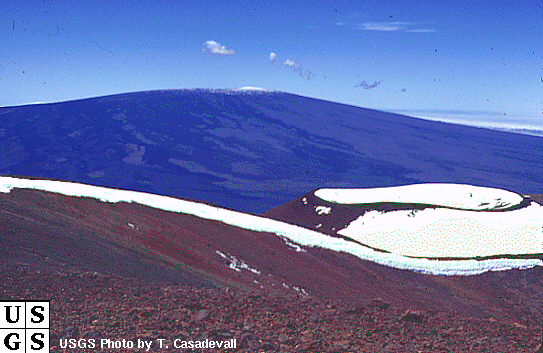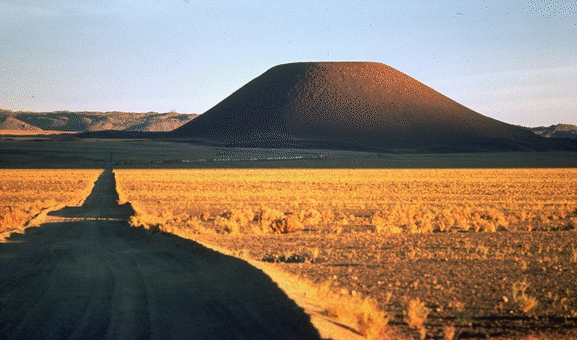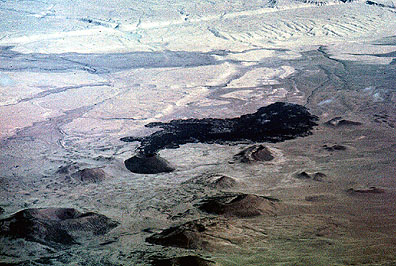
Volcanic Processes & Landforms
Volcanoes are spectacular (as well as dangerous) when they erupt, and they are among those geological features that give us a very clear sense of the power of geologic processes. Their magma originates in the upper mantle or the lower crust and varies in composition.
Volcanoes come in all shapes and sizes. The more common types are shield volcanoes, stratovolcanoes, and cinder cones.
Shield volcanoes gained their name from the fact that their profile against the horizon looks like a shield laying on the ground. The flanks of a shield volcano have low slopes, sometimes only a few degrees from horizontal. Shield volcanoes are the largest volcanic features on earth. The largest shield volcano, Mauna Loa in the Hawaiian Islands, has a volume 300 times greater than that of the largest stratovolcano, Mount Fuji in Japan. Shield volcanoes are created through the eruption of basaltic magmas, which flow easily and thus are capable of flowing over the landscape many miles from the central fissures or vents. The volcanoes observed on Mars are also classified as shield volcanoes. The largest one, Olympus Mons, is considered the tallest Mountain (24 km) in the solar system.

Photo of Mauna Loa, a shield volcano in Hawaii
Stratovolcanoes are volcanoes that consists of intermixed layers of lava flows and poorly consolidated volcanic material such as ash and cinders. Stratovolcanoes are typically located on continental crust above subducting plates and are easily recognized by their often beautiful symmetrically-shaped cones (Mt. Fuji in Japan is probably one of the better known examples).

Photo of Mt. Hood in Oregon, a stratovolcano that has been somewhat eroded by glacial
activity.
Cinder cones (tephra cone) are a type of
volcano that consists almost entirely of tephra (another term used for pyroclasts or solid
volcanic ejecta). Magma that contains abundant volatiles (gases) bubbles as it reaches the
surface and small bits of magma are thrown into the air in the process. They cool
down as they shoot through the air, and fall back down as solid particles. Depending
on their size they are described as ash (small), slag or cinder (a few cm in size), or as volcanic bombs (decimeters in size). From a distance,
cinder cones resemble piles of sand because they are made almost entirely of loose
material that has rained down from their central vent. These cones usually erupt lava
flows, too; however, the flows erupt through the side because the loosely piled cinders
that make up the cone are easily pushed outwards toward the side as magma attempts to move
up the central vent toward the peak. Usually the lava flows come towards the end of
the eruption, once the magma has lost enough of its volatiles to flow more quietly.
Cinder cone eruptions are comparatively short lived, and thus cinder cones are much
smaller features than stratovolcanoes and shield volcanoes (usually no more than a mile at
the base).

Photo of a typical cinder cone. The steep slopes reflect the angle of repose of the loose material (volcanic ash, slag, bombs) that the cone consists of.

A field of cinder cones. One cone has produced a lava flow (in black).
Where does Volcanism occur?
Abundant volcanism (most of it actually) does of course occur along the mid-oceanic ridges, but because these are covered with water we don't have much opportunity to see it.
Aside of mid-oceanic ridges, volcanoes occur most often above subducting slabs, forming
island arcs and volcanic arcs. These volcanoes are typically
stratovolcanoes. Additional volcanic activity is found in zones of crustal extension
(continental rifts) where faulting provides a conduit
for magma to reach the surface. In ocean basins, thousands of seamounts have been formed
over the past 200 million years as oceanic plates have drifted over assorted mantle hotspots. These volcanoes mark the trace of a plate as it
drifts steadily over the hotspot, which is fixed (or nearly so) in the mantle beneath the
plate.
Finally, flood basalts are voluminous outpourings of sheets of basaltic
magmas that are believed to originate when the head of a mantle hotspot (or plume) first
arrives beneath the base of a plate. Flood basalt eruptions are by volume the largest kind
of volcanic eruptions. The volumes of lava generated by far exceed the volume of
lave found in any given single volcano. Examples include the Columbia River Plateau basalts and the Deccan Trap
basalts of southern India. There are presently no active flood basalt provinces.
How fast do they form? How long do they last?
An active volcano can build itself in a few thousand years (or longer). Given that
the highest stratovolcanoes are more than 22,000 feet high (in the Andes), the rate at
which they increase in height is rather impressive. By their nature, most volcanoes build
themselves from the top down. Material is ejected from the central vent at or near the
volcanic peak, and gravity brings it down the slopes. The processes by which a volcano
builds its edifice depends on the type of volcano. For example, stratovolcanoes and shield
volcanoes build from the top downwards. In contrast, lava that flows from cinder cones is
emitted from its sides or near its base. Volcanic debris is transported onto the
surrounding area through direct eruption, wind and water, and landslides from the flanks
of the volcano.
The lifetime of a volcano in the landscape is less than that of most mountains for two
reasons. 1) Stratovolcanoes often self-destruct. During large eruptions, a volcano
sometimes ejects so much material from its interior magma chamber that too little material
is left inside to support the edifice of ejected material that comprises the material. In
these instances, the edifice can collapse downwards, i.e. the volcano caves in. Such a
collapse forms a caldera. These collapses can
occasionally remove thousands of feet of material from the top of a volcanic edifice.
In addition to caldera formation, landslides can also remove significant material from the
flank of a volcano. Such landslides can be initiated by volcanic or tectonic earthquakes
prior to an eruption, which appears to be what happened in the 1980 eruption of Mount St. Helens, or they can initiate an eruption since they
suddenly remove large amounts of material that sustained pressure on the magma chamber
(this process is analogous to removing a champagne cork - pressurized gas in the champagne
suddenly expands once the "plug" is removed).
Most volcanoes by their very nature are "poorly" constructed and top-heavy. They
are built from the top down of loose pyroclasts interleaved with lava flows. Consequently,
they are gravitationally unstable and prone to landslides if they are rained on or
destabilized by a small eruption or earthquake. What remains of a volcano long after
the poorly consolidated material ejected out of the cone has eroded away is its
erosion-resistant central plug (volcanic neck). Ship
Rock in New Mexico and Devil's Tower in Wyoming are excellent examples.
Geologically speaking, volcanoes are short-lived features, with lifetimes that typically
measure hundreds of thousands or a few millions of years. Nonetheless, at any given time,
the Earth's landscape is dotted with thousands of volcanoes and they are amongst the most
fascinating and memorable features on the Earth's surface.